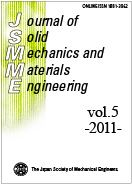All issues
Volume 5, Issue 5
Displaying 1-4 of 4 articles from this issue
- |<
- <
- 1
- >
- >|
Papers
-
Kiyohiko IKEDA, Hiroyuki KINOSHITA, Ryusuke KAWAMURA, Akira YOSHIKAWA, ...2011 Volume 5 Issue 5 Pages 209-218
Published: 2011
Released on J-STAGE: May 31, 2011
JOURNAL FREE ACCESSThe production of new materials by mixing together more than two raw materials is a useful method from the viewpoint of waste disposal. However, a number of trials and errors are required to produce the desired material. It is therefore important to clarify the target to improve the efficiency of production. In this study, as targets of production, glass-ceramics with anorthite, wollastonite, and gehelenite crystals are used, and inorganic wastes of fly ash, concrete sludge, and glass cullet are used as raw materials. The mixing ratios of these inorganic wastes are determined on the basis of the phase equilibrium diagram of CaO-Al2O3-SiO2. The XRD profiles and SEM observations showed that the crystallized phase of the glass ceramic samples produced were identified as anorthite, wollastonite, and gehelenite, respectively. Moreover, the strength, hardness, Young's modulus, fracture toughness, and acid resistance were measured. From the results, it is considered that glass-ceramics with wollastonite crystals are excellent in terms of mechanical properties, but those with anorthite are excellent in terms of chemical resistance.View full abstractDownload PDF (1606K) -
Dai-Heng CHEN, Kuniharu USHIJIMA2011 Volume 5 Issue 5 Pages 219-229
Published: 2011
Released on J-STAGE: May 31, 2011
JOURNAL FREE ACCESSIn this paper, the eccentricity of the progressive crushing of circular tubes subjected to an axial compression is studied using the finite element method (FEM). The eccentricity was found to depend on the thickness-to-radius ratio t/R0. Thus, the eccentricity for a thick tube is higher than that for a thin tube with the same radius. The reason why the eccentricity is a function of t/R0 and it is always greater than 0.5 is due to the different stress-strain relationships in the inner and outer folds generated in crushing. Based on this, an approximation equation is proposed to evaluate change of the eccentricity with the tube thickness. Furthermore, the validity of this equation was verified by the results of axial crushing test.View full abstractDownload PDF (543K) -
Takamoto ITOH, Wei CHEN, Ryuta YAMAMOTO2011 Volume 5 Issue 5 Pages 230-241
Published: 2011
Released on J-STAGE: May 31, 2011
JOURNAL FREE ACCESSThis study discusses multiaxial low cycle fatigue life of notched specimen under proportional and non-proportional loadings at room temperature. Strain controlled multiaxial low cycle fatigue tests were carried out using smooth and circumferentially notched round-bar specimens of type 316L stainless steel. Four kinds of notched specimens were employed with elastic stress concentration factors, Kt, as 1.5, 2.5, 4.2 and 6.0. The strain paths include proportional and non-proportional loadings. The former employed was a push-pull straining and a reversed torsion straining. The latter was achieved by strain path where axial and shear strains has 90° phase difference but their amplitudes are the same based on von Mises' criterion. The notch dependency of multiaxial low cycle fatigue life and the life estimation are discussed with employing inelastic finite element analysis. The lives depend on both Kt and strain path. The strain parameter for the life estimation is discussed with the non-proportional strain parameter proposed by an author with introducing Kt. The proposed parameter gave a satisfactory evaluation of multiaxial low cycle fatigue life for notched specimen of type 316L stainless steel under proportional and non-proportional loadings.View full abstractDownload PDF (491K) -
Miki YAMAZAKI, Tomio IWASAKI2011 Volume 5 Issue 5 Pages 242-250
Published: 2011
Released on J-STAGE: May 31, 2011
JOURNAL FREE ACCESSFor the stabilization of insulation performance in resin-molded insulators, strong adhesion between the resin and ceramic is required. In this paper, a new technique for the control of the interfacial strength in resin-molded structures has been proposed. The adhesive strength of the internal interface in a resin-molded structure was estimated as the interfacial fracture energy by using the molecular dynamics method. The interfacial fracture energy was qualitatively in agreement with the adhesive strength index obtained by a shear experiment. Based on the simulation results, the control of the interfacial strength was performed, and it became clear from the result that the interfacial strength between resin and ceramic can be improved up to the strength level of the glaze adhesion.View full abstractDownload PDF (733K)
- |<
- <
- 1
- >
- >|
